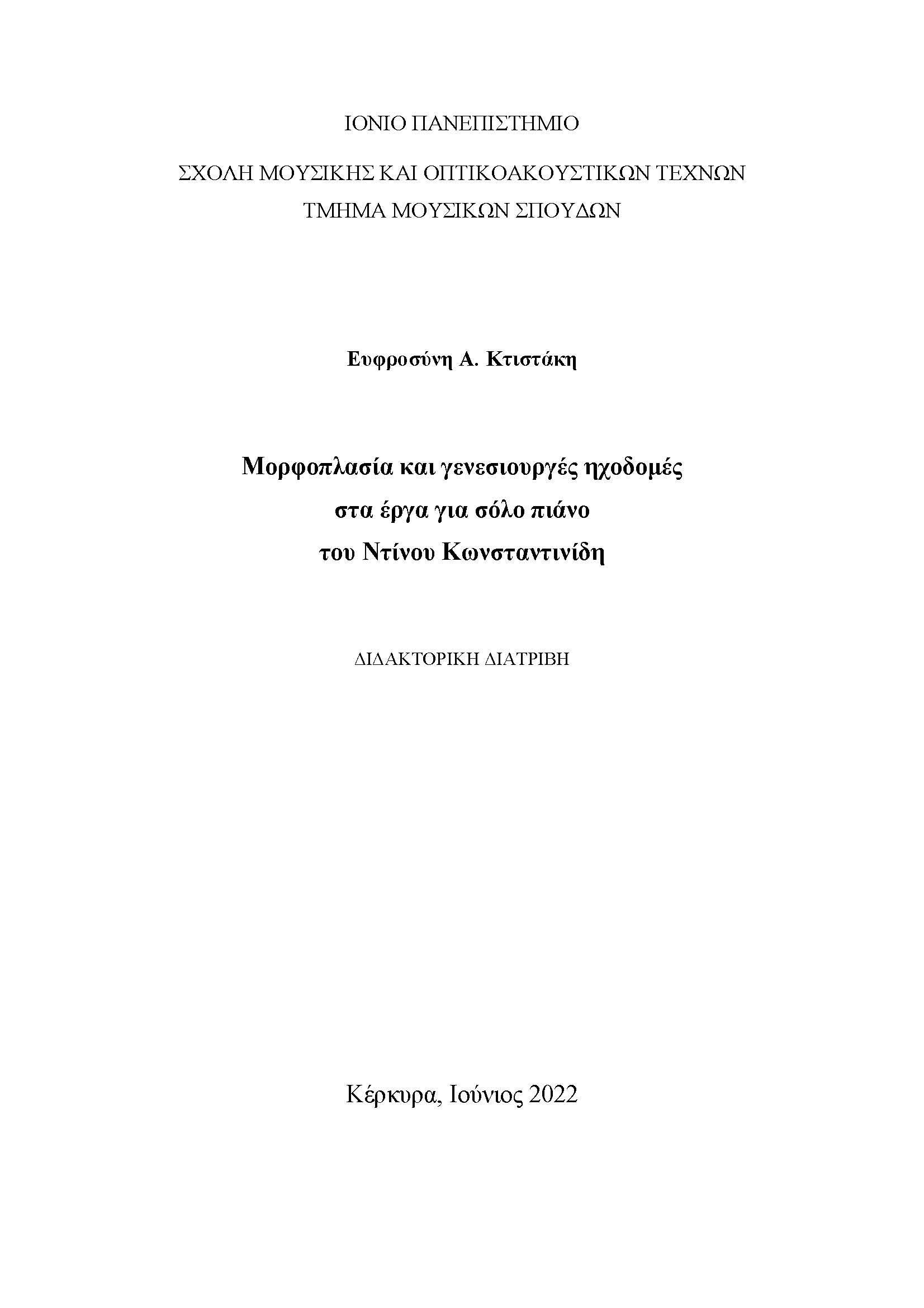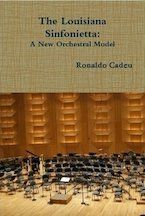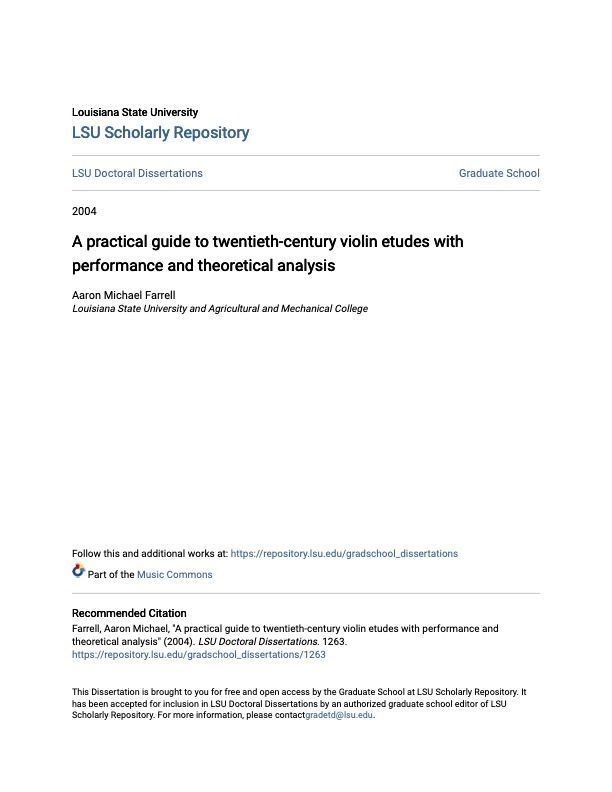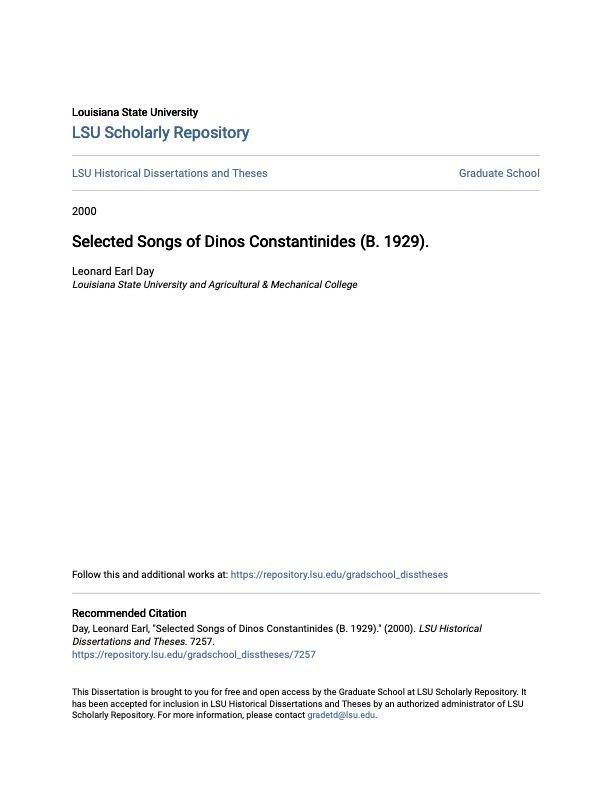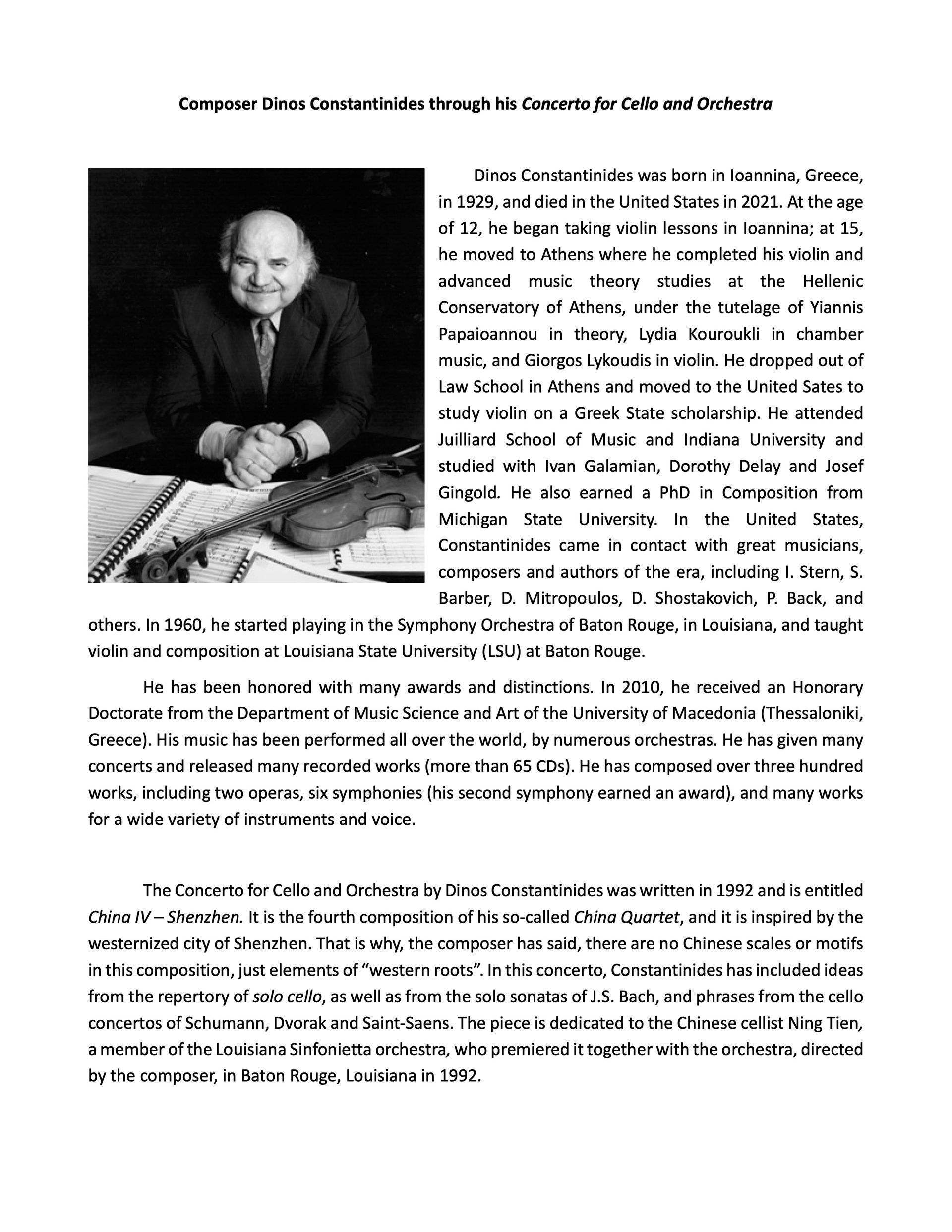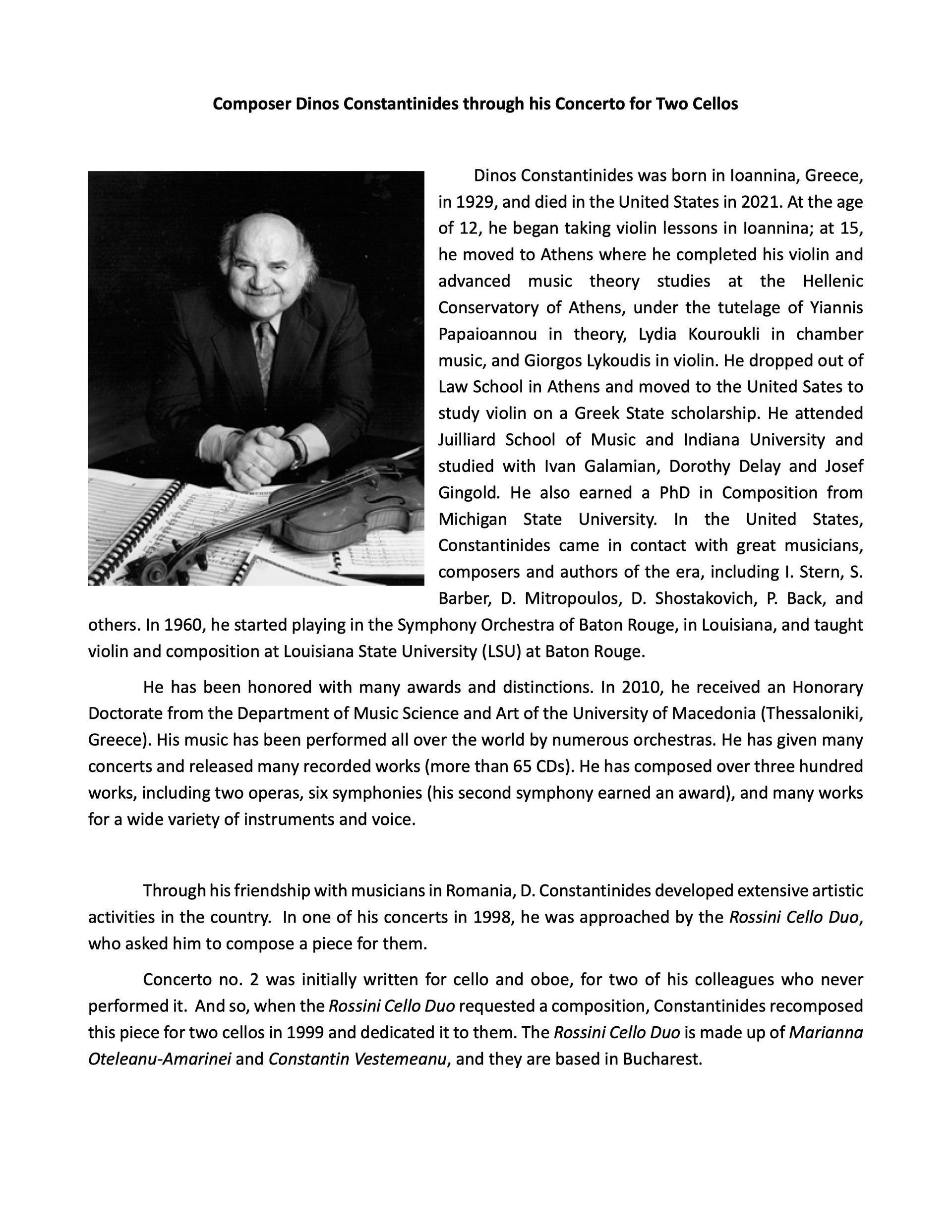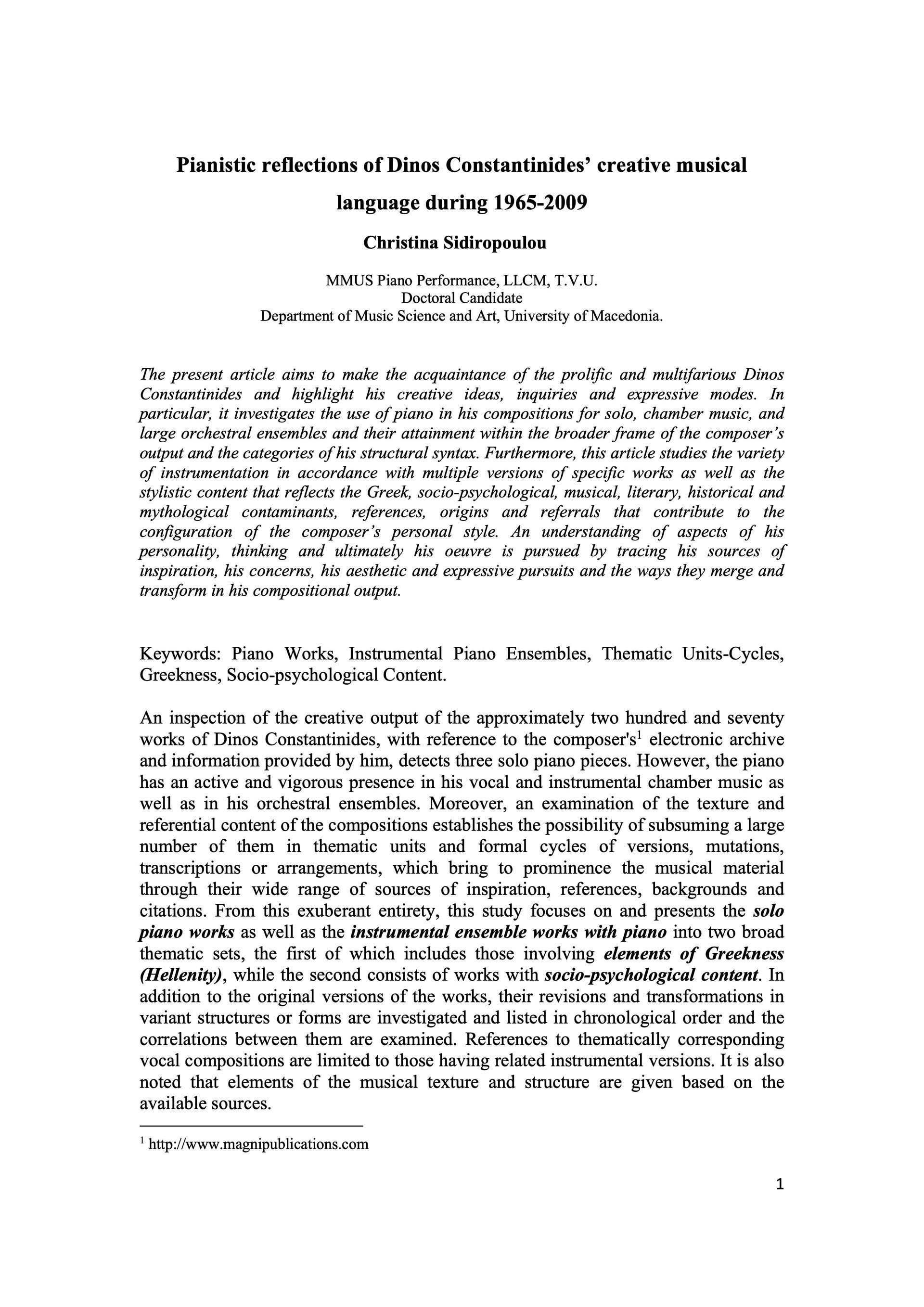analysis
dissertations
The Cello Concertos of Dimitris Themelis and Dinos Constantinides:Virtuosity and Musical Style Issues [in Greek]
Vicky Papanikolaou, University of Macedonia, Greece (2022)
The dissertation is based on the violoncello concertos by Greek composers Dimitris Themelis and Dinos Constantinides and examines the issues regarding their respective musical styles and virtuosity. Among other issues on these specific works, there is an ongoing research for Greek elements.
...
Dinos Constantinides was born in Ioannina in 1929. He passed away in July 2021 in Baton Rouge, Louisiana USA. He studied violin in Athens and at the Juilliard School in New York. He also studied composition and settled in Louisiana, USA in 1966. He has composed more than 300 works. His works have been interpreted worldwide. He has been the recipient of many awards and first prizes as a composer. He has composed two concertos for violoncello. The first one (1992) was premiered in the USA. Dimitris Patras, cellist and professor at the University of Macedonia, has played this concerto as well. Constantinides has moreover composed a double concerto for two violoncellos (1999) which also was premiered in the USA.
Form Planning and Sound Structures in Dinos Constantinides' Solo Piano Works [in Greek]
Froso Ktistaki, Ionian University, Greece (2022)
The thesis at hand studies the work of the composer Dinos Constantinides, focusing on his piano work production. One of the matters it seeks to treat is the frequency of use and the importance that the composer gives to elements loaned by the Greek musical tradition, and their utilization via the forms of the symphonic music of the western world. At the same time, it explores whether this case study, i.e., his solo piano works and his piano writing in general, depict—and to which degree—his personal “language” and his line of thinking as a composer. The in-depth approaches that followed focused on showcasing the underpinning logic and thus, the way sound expansion of pure piano writing is achieved, whilst at the same time, the selection criteria for this process were investigated. In other words, by examining Constantinides’ solo piano works, this thesis seeks to detect the—perhaps hidden—morphoplastic “forces” which govern the harmonic parameter, the orchestration and the development of the architecture of the large-scale form. Lastly, by examining the compositions of Dinos Constantinides in direct relation to other aspects of his creativity, an attempt is made to provide an answer as regards the symbolism and the programmatic character of his music, as this is reflected in the titles of his works. A deeper objective of this thesis is to understand the balance between the form and the content of the composer’s music, a matter approached both via the theoretical-analytical study and the performance-interpretation of his piano repertoire by the writer (pl. see Appendix 2. “Performances given”).
Pedagogical Methods of Nadia Boulanger and Dinos Constantinides: A Comparative StudyHarold Mims, Louisiana State University (2017)
The first part of this book is an original music composition for orchestra entitled, Concerto for Cello and Orchestra. In studying the life of pianist and conductor Daniel Barenboim (November 15, 1942 – ), I discovered a recording of his beautiful and gifted wife Jacqueline Mary Du Pré, (January 26, 1945 – October 19, 1987) performing Edward Elgar's Cello Concerto in E minor, Op. 85. This experience was the beginning of a love triangle between Elgar, Barenboim, and Du Pré. An attraction to Jacqueline goes deeper than just the music and the cello. Her career was not long due to multiple sclerosis which
forced her to stop performing at the age of twenty-eight. Barbara (my wife) was afflicted with this crippling disease, and our relationship began with both of us being musicians (Trumpet and French horn). The second part of the dissertation is a comparative study of the pedagogical methods of Nadia Boulanger and Dr. Dinos Constantinides.
The Organ Works of Dinos ConstantinidesGodwin Sadoh, Louisiana State University (2015)
A study of the organ works of Greek-American composer, Dinos Constantinides, would further elucidate the creative processes, complexities, and intrigues involved in composing for organ in the twentieth and twenty-first centuries.
The Louisiana Sinfonietta: A New Orchestral ModelRonaldo Cadeu de Oliveira, Louisiana State University (2010)
For many people, the orchestra, as it is now, is no longer something interesting, and as such it should be banished as an antique artifact. It is necessary to rethink the role of the orchestra. Maybe the major symphony orchestra as it is, and as it has been since 1800, needs to be restructured. The key consideration for that change would be how the orchestra interacts with and serves the community in which it is embedded. This is the precise perspective from which to examine the Louisiana Sinfonietta.
A Practical Guide to Twentieth-Century Violin Etudes with Performance and Theoretical AnalysisAaron M Farrell, Louisiana State University (2005)
Excerpt: Performance and Theoretical Analysis of Dinos Constantinides' Twentieth-Century Studies for Two Violins
The purpose of this paper is to provide musical, compositional, technical and pedagogical analysis of the collection of studies entitled Twentieth-Century Studies for Two Violins
by Dinos Constantinides. The performance analysis will expound on the contents (facts about intervals, bow strokes, extended instrumental techniques, etc.), the technical challenges (for the left and right hands, the ear, and the mind), and the musical requirements (phrasing, expression, etc.) set forth in the study. The musical and compositional analysis concerns the style, the harmonic, melodic, rhythmic, and metric language, as well as the phrase structure and formal design of the etude.
A Pedagogical and Comparative Study: Selected Songs of Dinos ConstantinidesLaura Mobley Thompson, University of Mississippi (2004)
This document is designed to provide a resource for teaching which will facilitate an informed artistic interpretation of selected songs of Dinos Constantinides. This study is based on the premise that the conscientious professional studio voice teacher must strive to remain current in choices pertaining to pedagogical techniques and literature. The vocal music of Dinos Constantinides, internationally distinguished composer, represents contemporary repertoire of the highest caliber. It is worthy of study and performance and is varied as to many parameters including style of composition, choice of poetry, accompaniment, and pedagogical considerations.
Selected Songs of Dinos ConstantinidesLeonard Earl Day, Louisiana State University (2003)
The purpose of this document is to better acquaint the reader with the composer, Dr. Dinos Constantinides and selected song compositions from the Four Songs on Poems of Sappho, Mutability, the Four Greek Songs, and Reflections VI – The Tyger. Other than modest citations in reference volumes and via the internet, little information is dedicated to his contributions as a composer of song. The author attempts to augment the aforementioned materials with new information that will provide a springboard for others interested in further study of the composer and his music.
articles
Pianistic Reflections of Dinos Constantinides' Creative Musical Language During 1965–2009
Christina Sidiropoulou, University of Macedonia, Greece (2009)
The present article aims to attain acquaintance and highlight the creative ideas, inquiries and expressive modes of the prolific and multifarious Dinos Constantinides. In particular, it investigates the use of piano in compositions for solo, chamber music, and large orchestral ensembles and pursues their accession within the broader frame of the composer’s output and the categories of his structural syntax. Furthermore, the presentation observes the variety of instrumentation in accordance with the multiple versions of the specific works and explores their stylistic content that reflect the Greek, socio-psychological, musical, literary, historical and mythological contaminants, references, origins and referrals, as contributing to the configuration of the composer’s personal style. The understanding of aspects of his personality, thinking and ultimately his oeuvre is pursued by tracing his sources of inspiration, his concerns, his aesthetic and expressive pursuits and the ways they merge and transform in his compositional output.
Four Articles on Composition in the New MillenniumDinos Constantinides (2000–2002)
At the turn of the century, Constantinides wrote four short articles for the College Music Society on the future of composition. The four articles are
- Music in the 20th Century and the Outlook for the New Millennium (2000)
- Composition in the 21st Century (2001)
- New Music and the Audiences (2001)
- Composition in the 21st Century: Another View (2002)


